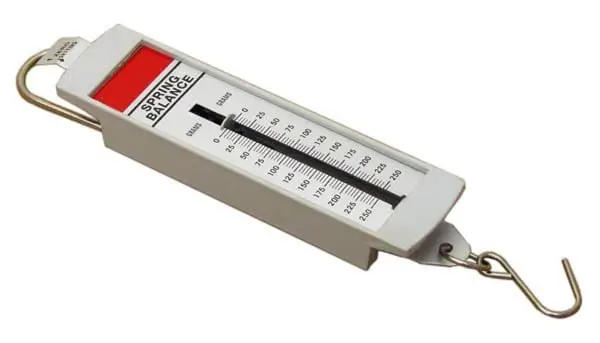For the majority of people, there is no difference between the mass and weight of an object. In other words, mass and weight are the same things. That’s why they are often used as synonyms for each other (we will talk about it later).
But, in reality, let me correct myself; according to their scientific definition, they are quite the opposite. So, have you ever wondered why there is so much confusion regarding that?
I mean, is mass the same as weight? Or, how is mass different from weight? Well, before answering these types of questions regarding these two physical quantities, let me give you a brief review!
Mass vs Weight (Tabular Form)
| MASS | WEIGHT | |
| 1. | Mass is a measurement of the amount of matter in an object. | Weight depends upon the effect of gravity. |
| 2. | It is a scalar quantity, therefore, has magnitude only. | It is a vector quantity, therefore, has both magnitudes as well as directions. |
| 3. | The mass of an object is the same everywhere. | The weight of an object changes depending on the magnitude of gravity. |
| 4. | It does not change according to the location. | It varies according to the location. |
| 5. | It can never be zero. | It can be zero, such as in space. |
| 6. | The SI unit of mass is the kilogram (kg). | The SI unit of weight is Newton (N). |
| 7. | Mass is represented by “m”. Its formula is m = w/g | Weight is represented by “W”. Its formula is W = mg |
| 8. | Mass is measured by using an ordinary or beam balance. | Weight is measured by using a spring balance. |
What is mass?
Mass is nothing but the amount of matter that the physical body posses. It is also a quantitative measurement of the resistance of the body to acceleration due to gravity (g).
It is a scalar quantity, therefore, does not change regardless of whether you are on Earth, in space, or on the surface of the moon. (We will talk about it in a later section).
Mass is an extensive property that specifically determines the strength of the force: a force that is nothing but a weight.
Must Read: Difference Between Distance and Displacement (Tabular Form)
What is Weight?
In purely scientific language, the weight of an object is nothing but an effect of force on the physical body due to gravity. That’s why in the tabular section, I said that force depends upon the effect of gravity.
It is a vector quantity, therefore, does change with respect to the location of its measurement. For example, if you are on Earth, your weight will be different.
Similarly, if you are on the surface of the moon, your weight will be different. In other words, you can say that without the effect of gravity, the weight of a physical body is nothing but a mass.
Measurement of mass and weight
From the above figure of speech, it is understood that mass and weight are definitely not the same things. They should not be used interchangeably in normal conversation.
Therefore, as a result, their measurement procedure should be quite different from each other. In this section, let’s get to know how they are being measured in their individual perceptions.
How is mass measured?

Measurement of mass is done by using an ordinary or beam balance. In fact, it is quite easy to perform. I mean, all you have to do is to compare the unknown mass with the known mass.
In order to neglect the effect of gravity, an ordinary balance works in a place where there is no gravity such as space. Refer to the above picture to understand it properly.
How is weight measured?

Measurement of weight is done by using a spring balance. Not to mention, spring balance is also known as spring scale or simply Newton meter.
A Newton meter consists of a spring fixed at one end and a hook at the other end. Whereas, a hook is a place where a measuring object is attached. Refer to the above picture to understand it properly.
Moreover, a spring balance cannot be used to measure the mass of the scale. WHY? Because it works due to the effect of gravity.
Special Mention: After multiple-use, the spring of the spring balance can be permanently stretched. Therefore, it is always recommended that before measuring the weight of an object, it should be properly calibrated to take an accurate measurement.
Units of mass and weight
Just like they are measured differently, therefore, as a result, they both should have different measuring units.
Unit of mass
The SI unit of mass is the kilogram (kg). In other words, you can say that according to the international system of units (SI), the mass is expressed in terms of Kilogram (kg).
The SI unit of mass never changes (well, till now). However, the way we calculate a kilogram has changed over time to time. Recently, on May 20, 2019, the standard definition of a kilogram has been revised in terms of the Planck constant.

Well, why not? I mean, nowadays, everything in this world is directly or indirectly related to the laws of quantum physics. Therefore, why the SI unit of mass should be exceptional?
Check out, Top 6 Game-Changing Facts About Quantum Physics You Definitely Never Knew
Unit of weight
The SI unit of weight is Newton (N). It bears the name of the great Issac Newton. Yup, the same one who put the final nail in the coffin of the earth-centered universe.
It was Newton who fundamentally separated weight from the mass. As Newton says, and I quote:
the weight of a body is the product of its mass and the acceleration due to gravity, thus distinguishing it from the mass for official usage
Relationship between mass and weight
Again, it was Issac Newton who, at first, derived the exact formula to define the relationship between mass and weight.
Newton’s second law of motion states that the force (F) acting on an object is equal to its mass (m) times its acceleration (a).
Now, for example, suppose a body of mass 1 kg falls towards the center of gravity, then what would be the required force?
Here, force is nothing but the weight of an object and mass is just mass. Similarly, acceleration is nothing but the force of gravity (g). According to Newton’s second law:
F = ma
where,
mass (m) = 1kg, acceleration (a or g) = 9.8kgm/s², and F = W (weight)
On solving,
W = (1kg)(9.8 m/s²) =9.8kgm/s² =9.8N.
The above result shows that a body on the surface of the earth has a mass equal to 1 kg. Then, it must have a weight equal to 9.8 N. In other words, the higher the mass of a body, the higher will be its weight, or vice versa.
Mass remains the same, but the weight does vary
Yup, you heard me right. Mass remains the same everywhere. However, weight does vary, of course, depending upon the location of its measurement. The only reason behind this variation in weight is the magnitude of its gravity.
In other words, the higher the magnitude of gravity, the higher will be the weight of an object, or vice versa. Moreover, if there is no gravity (space), the object will become weightless.
For example, if you are on the surface of the moon, your weight will be 1/6th of your weight on Earth. WHY? Because the moon’s gravity is 1/6th of the gravity of the Earth.
Similarly, if you are on the surface of Jupiter, your weight will be 2.64 times your weight on Earth. WHY? Well, solve it yourself!
Now, if I talk about space, in space, there is no gravity. Therefore, as a result, there will be no weight of an object. However, in all the above cases, the mass will remain the same.
Well, not only in space, an object can achieve weightlessness just above the surface of the earth. The physical process that aids an object to become weightless just above the earth’s surface is the principle of Buoyancy.
A common example of an object that appears to have no weight due to buoyant force is a hot air balloon. As the balloon rises above the earth, its weight gets distributed to the large surface area of the earth. Hence, making its weight difficult to measure.
Fun facts about mass and weight
For centuries, there is a common misconception going on regarding mass and weight i.e. they are most often thought to be the same physical quantities.
In other words, for the majority of people, there is no difference between them and i.e. scientifically wrong. Hence, as a result, they are misused in everyday life.
For example, suppose you are in a local market and buying an apple from some local vendor. The net weight of the product is actually referred to as its mass.
In other words, what you are buying is in terms of its mass i.e. a kilogram. And, what you refer to it is its weight.
That’s it for this post. If you like this article, share it if you like, like it if you share it. You can also find us on Mix, Twitter, Pinterest, and Facebook. Hey man, If you have come this far, do give us feedback in the comment section. It would make my day. Cheers!!!
You might also like:
- Dot Product vs Cross Product (Tabular Form)
- Difference Between Scalar and Vector (Tabular Form)
- Difference Between Conductors and Insulators (Tabular Form)
- Volt vs Ampere – Difference and Comparision
- Difference Between Balanced and Unbalanced Forces (Tabular Form)
- Petrol Engine vs Diesel Engine (Tabular Form)
- Difference Between Uniform and Non-uniform Motion with Examples
- Difference Between Speed and Velocity in Tabular Form
- Difference Between Periodic and Non-periodic Motion in Tabular Form
